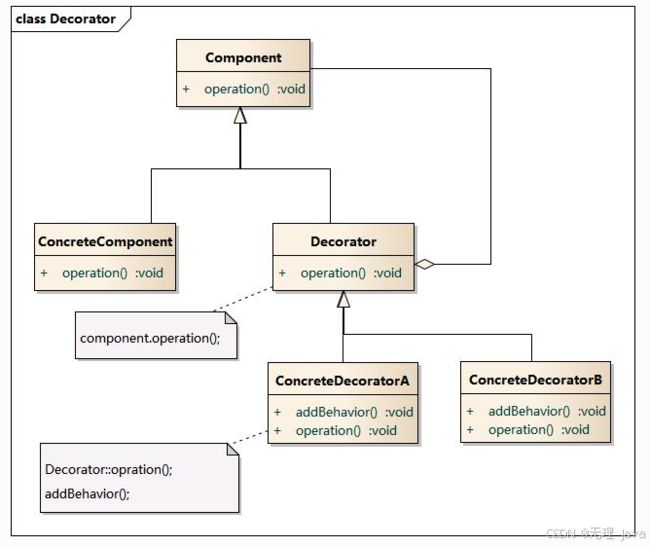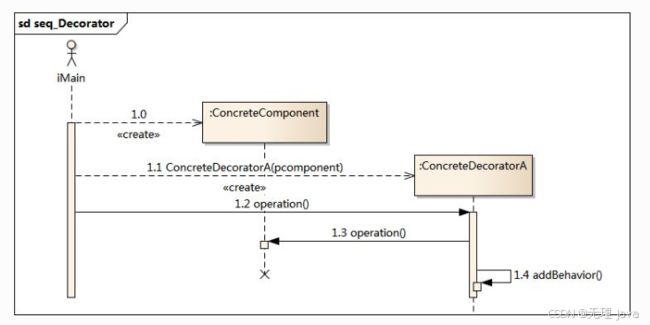【装饰器模式】设计模式系列: 动态扩展功能的艺术(实战案例)
文章目录
- Java设计模式系列:深入理解装饰器模式
-
- 1. 引言
-
- 设计模式简介
- 装饰器模式的定义
- 装饰器模式的应用场景
- 为什么使用装饰器模式
- 2. 装饰器模式的设计
-
- UML类图解释
- 接口与抽象类的选择
- UML和时序图
- 3. 装饰器模式的核心概念
-
- 组件接口 (Component)
- 具体组件 (Concrete Component)
- 装饰器 (Decorator)
- 具体装饰器 (Concrete Decorator)
- 4. 装饰器模式的优点与缺点
-
- 优点
- 缺点
- 5. 装饰器模式与其他模式的区别
-
- 与继承的区别
- 与适配器模式的区别
- 与代理模式的区别
- 6. 装饰器模式的实现
-
- Java代码示例
- 代码分析
- 7. 实战案例分析
-
- 代码实现
- 测试验证
- 性能考量
- 8. 装饰器模式的最佳实践
-
- 使用工厂模式创建装饰器
- 选择合适的装饰器组合
- 考虑性能影响
- 9. 常见问题与解决方案
-
- 如何解决性能瓶颈
- 如何处理多个装饰器的顺序问题
- 如何维护装饰器的可读性和可维护性
- 10. 总结
Java设计模式系列:深入理解装饰器模式
1. 引言
设计模式简介
设计模式是一种在软件工程领域内被广泛接受的通用解决方案。它描述了一种在特定情境下解决常见设计问题的方法,能够帮助开发人员减少代码重复并提高系统的可维护性和可扩展性。设计模式通常包含三个主要组成部分:模式名称、问题描述以及解决方案。
装饰器模式的定义
装饰器模式(Decorator Pattern)是一种结构型设计模式,允许在不改变现有对象结构的情况下动态地给对象添加新的功能。这种模式通过创建包含原有对象的新对象来实现这一点,从而可以向原有的对象添加职责(responsibilities)。
装饰器模式的应用场景
装饰器模式适用于以下情况:
- 当需要给一个系统中的对象动态地添加职责时。
- 当不能采用生成子类的方法来进行扩展时。例如,可能有多种扩展方法,每一种组合都会产生大量的子类,使得子类数目呈爆炸式增长。
- 当需要通过一些基本功能的排列组合衍生出更复杂的功能时。
为什么使用装饰器模式
- 动态扩展功能:装饰器模式能够在运行时为对象添加新行为,而无需修改其结构。
- 遵循单一职责原则:通过分离接口实现,每个类只负责一部分功能,这有助于维护和扩展。
- 替代继承:相比于通过继承来扩展功能,装饰器模式提供了更为灵活的方式,减少了类的数量,简化了类层次结构。
2. 装饰器模式的设计
UML类图解释
在装饰器模式中,UML类图展示了模式中涉及的主要类及其关系。类图包括以下几个关键部分:
- Component(组件接口):这是一个抽象接口或抽象类,定义了所有具体组件和装饰器类都需要实现的方法。
- ConcreteComponent(具体组件):实现了Component接口,是被装饰的对象。
- Decorator(抽象装饰器):同样实现了Component接口,它包含一个对Component类型的引用,并通过委托的方式调用该引用的方法。
- ConcreteDecorator(具体装饰器):继承自Decorator,用于添加新的行为或职责。
接口与抽象类的选择
在装饰器模式中,使用接口还是抽象类取决于具体情况:
- 如果你希望强制所有组件类和装饰器类遵循相同的接口,那么可以选择使用接口。
- 如果你希望在Component中提供某些默认的行为或者状态,那么可以使用抽象类。
UML和时序图
Component:定义了所有组件类(包括具体组件和装饰器)都需要实现的公共接口。ConcreteComponent:实现了Component接口,是被装饰的对象。AbstractDecor:实现了Component接口,包含一个Component类型的成员变量,并通过委托的方式调用该成员变量的方法。ConcreteDecorA和ConcreteDecorB:继承自AbstractDecor,用于添加新的行为或职责。
3. 装饰器模式的核心概念
组件接口 (Component)
组件接口是装饰器模式的基础,它定义了一个抽象接口或抽象类,所有具体的组件和装饰器类都需要实现这个接口。它是装饰器和被装饰对象共同遵守的契约。
public interface Component {
void operation();
}
具体组件 (Concrete Component)
具体组件实现了组件接口,它是我们要装饰的基本对象。这是装饰器模式中原始功能的提供者。
public class ConcreteComponent implements Component {
@Override
public void operation() {
System.out.println("具体组件的操作");
}
}
装饰器 (Decorator)
装饰器同样实现了组件接口,并持有具体组件的一个引用。装饰器通过委托的方式来执行具体组件的操作,并且可以在操作前后添加自己的行为。
public abstract class Decorator implements Component {
protected Component component;
public Decorator(Component component) {
this.component = component;
}
@Override
public void operation() {
component.operation();
}
}
具体装饰器 (Concrete Decorator)
具体装饰器实现了装饰器接口,并且在装饰器的基础上添加了额外的责任。它们通常会覆盖operation方法,并在执行原有操作之前或之后添加自己的行为。
public class ConcreteDecoratorA extends Decorator {
public ConcreteDecoratorA(Component component) {
super(component);
}
@Override
public void operation() {
super.operation();
addedBehaviorA();
}
private void addedBehaviorA() {
System.out.println("具体装饰器A添加的行为");
}
}
public class ConcreteDecoratorB extends Decorator {
public ConcreteDecoratorB(Component component) {
super(component);
}
@Override
public void operation() {
super.operation();
addedBehaviorB();
}
private void addedBehaviorB() {
System.out.println("具体装饰器B添加的行为");
}
}
4. 装饰器模式的优点与缺点
优点
1. 动态扩展功能
装饰器模式可以在运行时动态地给对象添加新的功能,而不需要修改对象本身的结构。这意味着可以在程序运行过程中根据需要选择性地添加新的职责。
2. 遵循单一职责原则
通过装饰器模式,可以将不同的功能拆分成多个类,每个类只关注单一的职责。这有助于保持各个类的简洁,也方便后续的维护和扩展。
3. 替代继承
相比于使用继承来扩展类的功能,装饰器模式提供了更为灵活的方式。它可以避免因过度使用继承而导致的类层次过于复杂的问题,同时也减少了由于继承而产生的耦合度。
缺点
1. 过多的具体类
在使用装饰器模式时,可能会因为需要添加不同的功能而创建大量的具体装饰器类。如果功能组合非常多样,那么类的数量可能会变得难以管理。
2. 可能增加系统复杂度
- 尽管装饰器模式能够带来灵活性,但过多的装饰器类也会使客户端代码变得更加复杂。客户端需要了解如何正确地组合装饰器以达到所需的功能。
5. 装饰器模式与其他模式的区别
与继承的区别
- 装饰器模式:可以在运行时动态地给对象添加新的功能,而不改变对象的结构。它通过封装对象并在其外围添加新功能来实现这一点。
- 继承:是一种静态类型关系,通过继承父类可以获取父类的所有属性和行为。继承在编译期就已经确定,无法在运行时动态改变。
与适配器模式的区别
- 装饰器模式:主要用于扩展对象的功能,它保留了对象的原有功能,并在其基础上添加新的行为。
- 适配器模式:主要目的是让两个不兼容的接口能够协同工作。适配器模式通常用来包装一个类的接口,使之与另一个接口兼容。
与代理模式的区别
- 装饰器模式:强调的是对对象功能的增强,它通常是在对象上添加额外的行为或责任。
- 代理模式:主要是为了控制对一个对象的访问,它提供了一个代理对象来作为访问目标对象的中介。代理模式通常用于远程代理、虚拟代理、缓存代理等场景。
总之,装饰器模式、适配器模式和代理模式虽然都是结构型设计模式,但它们解决的问题不同。装饰器模式关注的是动态地扩展对象的功能;适配器模式关注的是接口的转换;而代理模式关注的是控制对对象的访问。
6. 装饰器模式的实现
Java代码示例
1. 创建组件接口
public interface Component {
void operation();
}
2. 实现具体组件
public class ConcreteComponent implements Component {
@Override
public void operation() {
System.out.println("具体组件的操作");
}
}
3. 定义抽象装饰器
public abstract class Decorator implements Component {
protected Component component;
public Decorator(Component component) {
this.component = component;
}
@Override
public void operation() {
component.operation();
}
}
4. 创建具体装饰器
public class ConcreteDecoratorA extends Decorator {
public ConcreteDecoratorA(Component component) {
super(component);
}
@Override
public void operation() {
super.operation();
addedBehaviorA();
}
private void addedBehaviorA() {
System.out.println("具体装饰器A添加的行为");
}
}
public class ConcreteDecoratorB extends Decorator {
public ConcreteDecoratorB(Component component) {
super(component);
}
@Override
public void operation() {
super.operation();
addedBehaviorB();
}
private void addedBehaviorB() {
System.out.println("具体装饰器B添加的行为");
}
}
5. 客户端代码展示
public class Client {
public static void main(String[] args) {
Component component = new ConcreteComponent();
// 添加装饰器A
component = new ConcreteDecoratorA(component);
// 添加装饰器B
component = new ConcreteDecoratorB(component);
component.operation();
}
}
代码分析
1. 类之间的关系
Component接口定义了所有组件类需要实现的方法。ConcreteComponent实现了Component接口,是基本的功能提供者。Decorator抽象类实现了Component接口,并持有对Component类型的引用。ConcreteDecoratorA和ConcreteDecoratorB继承自Decorator,并在原有基础上添加新的行为。
2. 如何动态添加责任
- 通过构造函数传递具体组件到装饰器中,然后在装饰器中调用
component.operation()来执行具体组件的操作。 - 客户端可以通过创建新的装饰器实例并将已有的组件作为参数传递进去,从而动态地添加新的责任。
3. 如何避免过度使用装饰器
- 明确装饰器的目的和范围,避免不必要的叠加。
- 考虑使用组合装饰器来合并多个装饰器的功能,减少装饰器的数量。
- 在客户端代码中合理地使用装饰器,避免无限制地堆叠装饰器。
根据您的要求,下面是关于实战案例分析和装饰器模式最佳实践的部分草稿:
7. 实战案例分析
1. 案例背景介绍
假设我们正在开发一个简单的文本编辑器应用程序。该应用程序需要支持不同的文本格式化功能,如加粗、斜体、下划线等。这些格式化功能需要能够动态地添加到文本片段上,而且用户可以根据需要随时添加或移除这些格式化效果。
2. 需求分析
- 应用程序需要支持基本的文本显示功能。
- 用户可以动态地给文本添加加粗、斜体、下划线等格式化效果。
- 格式化效果可以按任意顺序添加或移除。
- 应用程序需要能够高效地渲染带有各种格式化效果的文本。
3. 设计决策
为了满足上述需求,我们决定使用装饰器模式来实现文本格式化功能。这样可以保证格式化效果能够动态地添加到文本片段上,而不会改变文本片段的基本结构。
代码实现
1. 创建组件接口
public interface TextComponent {
String formatText(String text);
}
2. 实现具体组件
public class PlainTextComponent implements TextComponent {
@Override
public String formatText(String text) {
return text;
}
}
3. 定义抽象装饰器
public abstract class TextDecorator implements TextComponent {
protected TextComponent textComponent;
public TextDecorator(TextComponent textComponent) {
this.textComponent = textComponent;
}
@Override
public String formatText(String text) {
return textComponent.formatText(text);
}
}
4. 创建具体装饰器
public class BoldTextDecorator extends TextDecorator {
public BoldTextDecorator(TextComponent textComponent) {
super(textComponent);
}
@Override
public String formatText(String text) {
return "" + super.formatText(text) + "";
}
}
public class ItalicTextDecorator extends TextDecorator {
public ItalicTextDecorator(TextComponent textComponent) {
super(textComponent);
}
@Override
public String formatText(String text) {
return "" + super.formatText(text) + "";
}
}
public class UnderlineTextDecorator extends TextDecorator {
public UnderlineTextDecorator(TextComponent textComponent) {
super(textComponent);
}
@Override
public String formatText(String text) {
return "" + super.formatText(text) + "";
}
}
5. 客户端代码展示
public class TextEditorClient {
public static void main(String[] args) {
TextComponent textComponent = new PlainTextComponent();
// 添加加粗装饰器
textComponent = new BoldTextDecorator(textComponent);
// 添加斜体装饰器
textComponent = new ItalicTextDecorator(textComponent);
// 添加下划线装饰器
textComponent = new UnderlineTextDecorator(textComponent);
String formattedText = textComponent.formatText("Hello, world!");
System.out.println(formattedText);
}
}
测试验证
为了验证装饰器模式是否正确实现了所需的格式化功能,我们可以编写单元测试来检查不同装饰器组合下的文本输出是否符合预期。
public class TextFormatterTest {
@Test
public void testBoldItalicUnderline() {
TextComponent textComponent = new PlainTextComponent();
textComponent = new BoldTextDecorator(new ItalicTextDecorator(new UnderlineTextDecorator(textComponent)));
String formattedText = textComponent.formatText("Hello, world!");
assertEquals("Hello, world!", formattedText);
}
@Test
public void testItalicBoldUnderline() {
TextComponent textComponent = new PlainTextComponent();
textComponent = new ItalicTextDecorator(new BoldTextDecorator(new UnderlineTextDecorator(textComponent)));
String formattedText = textComponent.formatText("Hello, world!");
assertEquals("Hello, world!", formattedText);
}
}
性能考量
- 字符串构建:在装饰器模式中,每次调用
formatText方法时都会重新构建字符串,这对于频繁的格式化操作来说可能会导致性能下降。 - 内存消耗:每添加一个新的装饰器,就会创建一个新的对象,这可能导致内存消耗增加。
- 优化策略:可以考虑使用StringBuilder来构建字符串,或者使用缓存机制来存储已经格式化的文本,以减少重复计算。
8. 装饰器模式的最佳实践
避免过度装饰
- 在设计时明确装饰器的目的和范围,避免不必要的叠加。
- 使用组合装饰器来合并多个装饰器的功能,减少装饰器的数量。
使用工厂模式创建装饰器
- 创建一个工厂类来管理装饰器的创建过程,这样可以隐藏装饰器的创建细节,并简化客户端代码。
- 工厂类可以根据需要创建不同类型的装饰器组合。
public class TextDecoratorFactory {
public static TextComponent createDecorator(String type, TextComponent component) {
switch (type) {
case "bold":
return new BoldTextDecorator(component);
case "italic":
return new ItalicTextDecorator(component);
case "underline":
return new UnderlineTextDecorator(component);
default:
throw new IllegalArgumentException("Unsupported decorator type: " + type);
}
}
}
选择合适的装饰器组合
- 根据实际需求选择最合适的装饰器组合,避免不必要的装饰器层叠。
- 考虑使用复合装饰器来减少对象的数量和提高性能。
public class CompositeTextDecorator extends TextDecorator {
public CompositeTextDecorator(TextComponent textComponent) {
super(textComponent);
}
public void addDecorator(TextDecorator decorator) {
// Implement the logic to add a new decorator to the composite.
}
}
考虑性能影响
- 对于性能敏感的应用场景,考虑使用缓存或其他优化技术来减少装饰器模式带来的开销。
- 监控装饰器模式在实际应用中的性能表现,并根据需要进行调整。
9. 常见问题与解决方案
如何解决性能瓶颈
装饰器模式在动态扩展对象功能方面非常有用,但在某些情况下可能会导致性能问题。以下是一些常见的解决方案:
- 使用StringBuilder而非String拼接:当装饰器需要对字符串进行多次操作时,使用
StringBuilder来构建最终的字符串可以显著提高性能。 - 缓存装饰结果:如果装饰器返回的结果可以复用,可以考虑缓存这些结果,以避免重复计算。
- 使用代理模式:对于复杂的装饰逻辑,可以考虑使用代理模式来进一步优化性能。例如,在代理类中实现缓存机制,以减少实际装饰器的调用次数。
如何处理多个装饰器的顺序问题
装饰器模式的一个特点是装饰器的顺序会影响最终结果。为了处理多个装饰器的顺序问题,可以采取以下措施:
- 在客户端代码中显式指定装饰器的顺序:在客户端代码中,明确地创建装饰器的顺序可以确保装饰器按照预期的顺序应用。
- 使用工厂模式来管理装饰器的顺序:通过工厂模式创建装饰器时,可以预先定义好装饰器的顺序,这样客户端只需要请求特定的装饰器组合即可。
- 提供装饰器组合类:创建一个装饰器组合类,允许用户指定装饰器的顺序,这样可以简化客户端代码并提高可维护性。
如何维护装饰器的可读性和可维护性
随着装饰器数量的增加,代码的可读性和可维护性可能会受到影响。以下是一些建议:
- 使用有意义的命名:确保装饰器的命名清晰明了,能够反映其提供的功能。
- 限制装饰器的数量:尽量避免过度使用装饰器,可以通过组合多个装饰器来减少装饰器的数量。
- 使用文档和注释:为装饰器类添加详细的文档和注释,说明其用途和使用场景。
- 重构和模块化:定期审查装饰器模式的实现,并考虑将其分解成更小的模块或重构为更简单的形式。
10. 总结
1. 装饰器模式的适用场景回顾
- 当需要给一个对象动态地添加职责时。
- 当不能采用生成子类的方法来进行扩展时。
- 当需要通过一些基本功能的排列组合衍生出更复杂的功能时。
2. 关键点总结
- 动态扩展功能:装饰器模式能够在运行时为对象添加新行为,而无需修改其结构。
- 遵循单一职责原则:通过分离接口实现,每个类只负责一部分功能,这有助于维护和扩展。
- 替代继承:相比于通过继承来扩展功能,装饰器模式提供了更为灵活的方式,减少了类的数量,简化了类层次结构。
3. 后续学习方向
- 深入学习其他设计模式:探索更多设计模式,如适配器模式、代理模式等,了解它们与装饰器模式之间的关系。
- 实践项目中的应用:尝试在实际项目中应用装饰器模式,以加深对其的理解和掌握。
- 性能优化技巧:研究如何在使用装饰器模式时进行性能优化,特别是对于性能敏感的应用场景。
- 扩展应用场景:探索装饰器模式在不同领域的应用,如网络编程、图形界面等。
本文详细介绍了23种设计模式的基础知识,帮助读者快速掌握设计模式的核心概念,并找到适合实际应用的具体模式:
【设计模式入门】设计模式全解析:23种经典模式介绍与评级指南(设计师必备)

